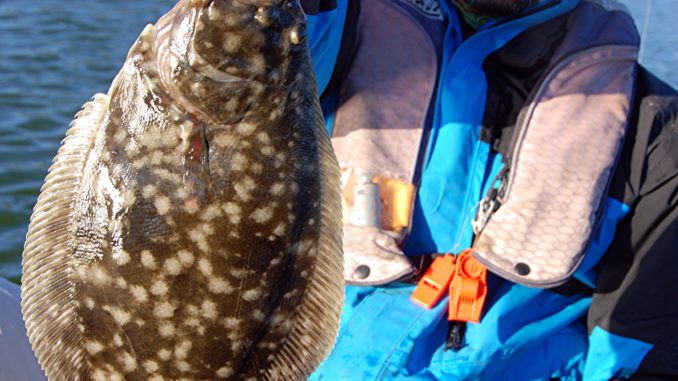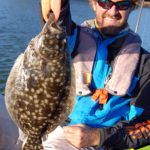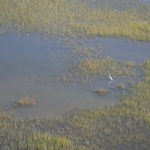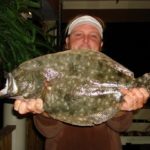
The fall spot run along the South Carolina coast is often followed by the best flounder fishing of the year.
The spot run each fall causes a lot of excitement along the Grand Strand, and few are immune to the frenzy of the tasty panfish. J Baisch of Fishful Thinking Charters in Murrells Inlet also gets excited about the annual migration, but it’s not because of what’s in front. It’s what’s behind.
“The big female flounder — the big ones, I’m talking 5 pounds, doormat females — they follow the spots,” said Baisch. “Depending on how good our spot run is decides how many big female flounder come into the inlet. I always catch my biggest flounder of the year in the inlet in the last of October, first week in November.”
Trolling is still widely recognized for producing big numbers of flounder in the inshore waters of Murrells Inlet, which are like none other along the coast. A lot of current flows through the inlet, and because of its relative small size, the tides turn more quickly than in other larger inlets fed by river system. That means there’s rarely any slack time, and when the current is moving, it’s moving fast.
The currents and sands may explain why flounder are more prone to school up around ambush points: docks, oyster beds, creek drainages or anything that provides a fish a place to lay up and wait for passing prey. It also explains why Baisch isn’t a fan of trolling.
“Flounder are no different than anything else that you hunt or fish for on land or in water — 90 percent of the game hit 10 percent of the area,” he said. “That’s just how it is. As soon as you start figuring out where those 10-percent areas are, you’re on the fish. If you’re trolling out there in the long, open stretches, 90 percent of the time, you’re only where 10 percent of the fish are.”
Baisch prefers to cast to these 10-percent areas where he feels he can get on the fish more quickly and stay on them longer than a fisherman trolling who may or may not be able to haul the whole train around to get back to a spot that’s holding fish. Not only does he not troll, he rarely anchors if he can help it. Instead he will nose the boat up on the bank and fish out the back, offering a much steadier platform that a boat rocking from the constant parade of wakes in the inlet.
Baish employs two different rigs for flounder. The first is a standard Carolina rig with a 2-foot leader ahead of just enough of any egg sinker to maintain contact with the bottom. He fishes a “sausage-sized” mullet in the 4- to 6- or even 8-inch range on a 2/0 Kahle-style hook. His other rig is a section of 20- pound fluorocarbon leader tied to a 3/4-ounch Mission Fishin’ stand-up jighead that allows the hook to ride in an upward position and stay relatively free of obstructions. He’ll thread on a live mullet or a 3- to 4-inch Gulp shrimp in new penny color. With this rig, he can rapidly pop the jighead across the bottom in staccato fashion, then pause and slide the bait. He said most of the bites come as the bait settles down from popping it off the bottom, swimming it in shrimp fashion.
“I literally just bounce it across the bottom,” he said. “I keep my rod tip real high and I really just ‘ding, ding, ding, ding’ and try to make the bait move without actually move the jighead.
“A lot of times, those fish will eat while you’re doing that, but you can’t feel it, so that’s why I do a 6-, 8- or 10-inch drag afterwards just to see if anything latched on.”
With the Carolina rig, Baisch said it’s better to wait once you feel the bite and let the fish scale the bait, turning it in its mouth, which better positions the hook to get into position. With the jighead, he will typically set the hook at the first indication that a fish is on.
“The jighead has to be able to stand up so the fish gets the hook on the initial bite,” he said. “I also like the Gulp shrimp because you can repeatedly cast with it. A mud minnow will be dead after two or three casts, but the shrimp stays lively because of the action I give to it.”
Justin Carter of Mount Pleasant, who recently made the switch from guiding fishermen in kayaks to chartering inshore in traditional vessels, said fishing patterns in the waters around Charleston can be great, even though they’re different from what Baisch sees in Murrells Inlet.
South Carolina’s terrain creates two distinct habitats for flounder, with a dividing line around the center of the state’s coast. The distinction is a rich, earthly, slippery, brown-gray substance called pluff mud.
“One of the big differences in South Carolina’s coast versus other parts of the country is our pluff mud, which runs pretty much from just north of Georgetown all the way down to the Georgia border and then some,” Carter said. “It’s a unique ecosystem. It does limit the amount of flounder we get in some areas. We have larger amounts of flounder in the north, but that also helps narrow down the most-likely places to find flounder, namely sandy points and rocky areas.”
Areas that have riprapped walls, jetties or rock groins to prevent sand erosion are tops on Carter’s list of flounder spots. He prefers an incoming tide, because incoming in the fall means clearer, cooler water, and outgoing typically mean dirtier, hotter water.
“Flounder always feed into the current,” he said. “That’s why I always position downcurrent, throw my bait upcurrent and work it with the flow along whatever structure or bottom cover I’m targeting.”
Like Baisch, Carter prefers casting with a ¼-ounce jighead and a 5-inch Z-Man StreakZ parallel to a line of rocks. The first cast will be on the edge of the rocks, and he’ll hop the bait over the top of the structure. The second cast will be at the base of the rocks where they meet sand.
“I just never catch many flounder in places where there’s nothing but brown pluff mud,” said Carter. “Maybe it’s because they prefer to camouflage in broken areas, but I do much better on hard, rocky bottom or hard, sand bottom.”
DESTINATION INFORMATION
HOW TO GET THERE — Murrells Inlet is south of Myrtle Beach and north of Georgetown on US 17 Business. A public boat ramp is in the middle of the town’s famous seafood district. Charleston is at the intersection of US 17 and I-26, at the junction of the Wando, Cooper and Ashley rivers.
WHEN TO GO — The run of big, female flounder starts shortly after the fall spot run up and down South Carolina’s coastline, typically the last half of October and into early November before waters cool enough to send flounder out of inlets into the warmer ocean waters.
BEST TECHNIQUES — Flounder are caught using three primary techniques. Casting live or artificial baits into ambush spots such as creek and gutter drainages, sandbar rips and scour holes accounts for good numbers of fish. Use a Carolina-rigged mullet minnow in the 4- to 8-inch size range, with a 24-inch leader. A 1- to 2-inch crappie float may be added at the mid-point of the leader to keep the bait off the bottom and out of oyster shells. Second is fishing a live mullet minnow or a scented soft-plastic such as a Gulp Shrimp or a Z-Man on a stand-up jighead tied to a 24-inch section of heavy monofilament leader. Flounder can also be caught from an anchored boat by casting a Carolina-rigged live bait around oyster mounds or jetty rocks. Leave the bait stationary once it’s on the bottom.
FISHING INFO/GUIDES — J Baisch, Fishful Thinking Guide Service, 843-902-0356, www.fishthinkguidesc.com; Justin Carter, DIG Charters, 843-725-8784, www.charlestoninshoreandoffshorecharters.com. See also Guides and Charters in Classifieds.
ACCOMMODATIONS — Myrtle Beach Chamber of Commerce, 800-356-3016, www.myrtlebeachareachamber.com; Best Western Patriots Point, Mount Pleasant, 843-971-7070; Town and Country Inn & Conference Center, Charleston, 800-334-6660; LaQuinta Inn & Suites, Charleston, 843-556-5200.
MAPS — Maps Unique, 910-458-9923, www.mapsunique.com; Grease Chart, 800-326-3567, www.greasechart.com; Capt. Segull’s Nautical Charts, 888-473-4855, www.captainsegullcharts.com; Sealake Fishing Guides, 800-411-0185, www.thegoodspots.com.






